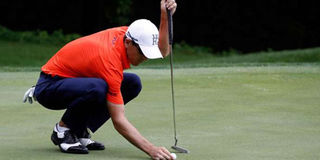Long cliff-hanger wait could cost more than a penalty shot

Scott Langley lines up a putt on the ninth hole during the continuation of the first round of the John Deere Classic at TPC Deere Run on August 12, 2016 in Silvis, Illinois. PHOTO | ANNA PAPUGA |
What you need to know:
- The Rules of Golf cover the cliff-hanger situation where the ball stops at the lip of the hole.
With the return of the game of golf to the Olympics, there was an Internet meme of a 2014 incident, in which Scott Langley’s golf ball hang on the lip of a hole for 22 seconds.
In the Olympics meme, the 2014 video is redone this time with a hearty commentary akin to the South American football commentators.
In the clip, Scott Langley has what looks like a 10-foot putt for birdie. He putts and the ball seems to stop at the back of the hole
The ball seems to be stationary and takes long to fall into the hole, which it eventually does.
The first time I saw the clip I smiled and thought of the way golf was so different from football. Then my golf refereeing juices automatically kicked in and I quickly got my stopwatch and replayed the clip.
The putt is one of those that have a left-to-right break or borrow. The ball seems to stop right behind the hole and Scott, the player, stays in his position egging the ball to drop into the hole.
After about eight seconds, he moves forward and steps to the side and watches the ball for a few more seconds before the ball finally falls to the hole. When I saw the video, my first thought was that I had a question for the WhatsApp groups where I send rules questions weekly.
The Rules of Golf cover the cliff-hanger situation where the ball stops at the lip of the hole. The Rule states: When any part of the ball overhangs the lip of the hole, the player is allowed enough time to reach the hole without unreasonable delay and an additional 10 seconds to determine whether the ball is at rest.
If by then the ball has not fallen into the hole, it is deemed to be at rest. If the ball subsequently falls into the hole, the player is deemed to have holed out with his last stroke and must add a penalty stroke to his score for the hole…
According to this Rule, Scott Langley should have been penalised one stroke and should not have gotten his birdie. From my timing, he took 22 seconds from the time he putted to the time the ball dropped into the hole.
Since he did not immediately walk to the ball without delay, I made an allowance of six seconds, which I reckon were very generous. That left 16 seconds and that meant that the ball dropped way after the allowable 10 seconds.
I usually don’t get members of the WhatsApp groups questioning the answers that I give on the weekly questions. However one gentleman questioned my decision on this particular case and he even consulted the all-knowing Google and came up with excerpts showing that the birdie for Scott Langley actually counted.
At this point, I consulted other referees based in the UK who have had a lot more experience in Rules of Golf than I have. The first referee came up with the same answer that I had given.
I was feeling content and was about to tell the fellow not to believe all the “panganga” he sees on the Interwebs. Then the second referee came back and informed me that what was not visible on the video clip, was that the ball had not stopped moving.
Under a different rule, a player must not make a stroke at his ball while it is moving. Scott would have incurred a two-stroke penalty had he tapped his ball into the hole as it was not at rest.
The only time a player is allowed to make a stroke at such a moving ball is if he had started the backward movement of the ball when the ball started moving. Since Scott’s ball had not come to rest after the initial putt, he would not have logically been able to tap the ball into the hole. He was justified in waiting for 22 seconds.
WHATSAPP GROUPS
To all the golfers in the WhatsApp groups where I send the rule of the week questions; this week’s question was faulty. Scott Langley did make the birdie. I apologise for misleading you. I however hope that the lesson of the week was not lost.
You cannot wait indefinitely for an earth tremor or wind to assist you in dropping a cliff-hanger. If your ball stops at the edge of the hole, you must walk to the hole without delay and you are only allowed to wait for 10 seconds.
Waiting for too long or slow play may be hazardous to your health. If you doubt this, search the Interwebs for the golfer who was stabbed for slow play in the US.
The author is a KGU Executive




